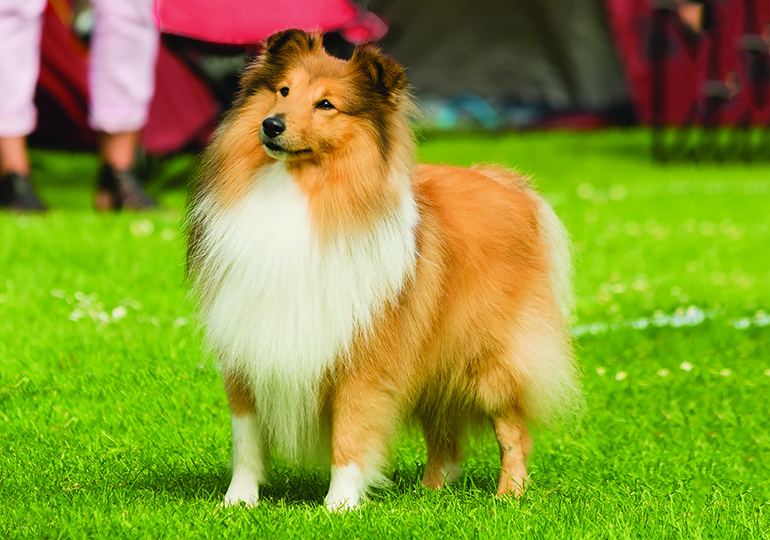
GROUP 5 - WORKING DOGS
Shetland Sheepdogs are small, long-haired, working dogs of great beauty, originally bred to herd sheep in the rugged terrain of the Shetland Islands, north of the United Kingdom and west of Norway and were settled by the Norse (Vikings) in 920AD.
These settlers brought with them cattle, sheep and dogs; and archaeological remains of the dogs indicate they were of typical Spitz descent, resembling what we now know as Buhund and related breeds. These dogs were an all purpose dog, useful around the crofts or farms, but with no specific role, in what was a hard windswept environment where only low and sparse vegetation could grow and few sheep, cows and ponies could exist; a hard and poor environment for man and animals alike to survive.
Their appearance resembles that of a small Collie (Rough), but they are indeed an individual breed with features, apart from size, that distinguish them from their larger relatives. They are a small, long-haired, working dog of great beauty, free from cloddiness and coarseness; action lithe and graceful. Outline symmetrical, so that no part appears out of proportion to whole. Abundant coat, mane and frill, shapely head and sweet expression.
Head and skull: head refined and elegant with no exaggerations; when viewed from top or side a long, blunt wedge, tapering from ear to nose.
Eyes: medium size; obliquely set; almond shape. Dark brown except in the case of merles, where one or both may be blue or blue flecked.
Colour: Sable; Tri-colour; Blue Merles; Black and White; Black and Tan.
Sizes: dogs 37cm at withers; bitches 35.5cm at withers. (1)
Alert, gentle, intelligent, strong and active.
The Australian Breed Standard summarises the Shetland Sheepdog’s temperament as “affectionate and responsive to his owner, reserved towards strangers, never nervous”.
Shelties are hardy, durable little sheepdogs which thrive on attention and praise. They are gentle dogs, making them great companions for children and adults alike. Like all working dogs they are quite active but, because of the smaller size, suit the average suburban-size backyard while also enjoying walks or excursions. They make superb house pets and are very adaptable.
Shelties possess a keen intelligence and aptitude to training, which makes them suitable for many performance disciplines. They perform at the highest levels of Obedience, Agility, Herding and many other dog-sports activities. Their easy going nature makes them great companions for other pets. As with all dogs, socialisation and training from a young age is highly recommended.
Shelties are double coated, with a harsh, longer outer coat and a soft, dense undercoat; these were developed to be durable and weather resistant when the dogs worked stock on the Shetland Isles.
While regular maintenance is necessary, this is not as much work as may first be assumed. Most breeders recommend
a thorough 10-minute brushing about once a week to keep the lovely coat free from knots and tangles, with particular attention paid to legs, stomach and behind the ears.
Regular baths will also help keep the coat in good condition. Shelties will shed their undercoat approximately every six months.
Shelties will suit almost any family or home situation that can give them the love and attention they deserve. Their size makes them suitable to many families and their gentle, intelligent and affectionate nature also makes them loyal and endearing pets.
Shelties are primarily a healthy breed of dog, with an average lifespan of between 12 to 16 years and only a few known congenital conditions, as with all animals (and humans).
Some Shelties may be affected by an eye condition called Collie Eye Anomaly. Collie Eye Anomaly (CEA) is a congenital, recessively inherited eye defect that affects the development of the choroid (an important tissue under the retina) and is also found in other breeds.
Responsible breeders strive to decrease the incidence of such eye conditions in the Shetland Sheepdog through careful breeding plans and by supporting further veterinary research.
Information from the Shetland Sheepdog Club of NSW
Ref (1): Source Ankc.org.au
Image: Shutterstock.com
Now you know a little about the Shetland Sheepdog you may have think that this is the dog for you. Before you make a decision, please make contact with the breed club or your State controlling body for purebred dogs. They will be able to give you information about available puppies and also suggest dog shows where you can see the breed and speak to breeders. In this way you will gain a better perspective of the Shetland Sheepdog and its needs and whether this breed would suit your lifestyle.